
![]() Download the full report (PDF)
Download the full report (PDF)
Statistics
All the statistics used in this report were obtained using Kaspersky Security Network (KSN), a distributed antivirus network that works with various anti-malware protection components. The data was collected from KSN users who agreed to provide it. Millions of Kaspersky Lab product users from 213 countries and territories worldwide participate in this global exchange of information about malicious activity.
Q3 figures
- According to KSN data, Kaspersky Lab solutions detected and repelled 171,802,109 malicious attacks from online resources located in 190 countries all over the world.
- 45,169,524 unique URLs were recognized as malicious by web antivirus components.
- Kaspersky Lab’s web antivirus detected 12,657,673 unique malicious objects: scripts, exploits, executable files, etc.
- Attempted infections by malware that aims to steal money via online access to bank accounts were registered on 1,198,264 user computers.
- Crypto ransomware attacks were blocked on 821,865 computers of unique users.
- Kaspersky Lab’s file antivirus detected a total of 116,469,744 unique malicious and potentially unwanted objects.
- Kaspersky Lab mobile security products detected:
- 1,520,931 malicious installation packages;
- 30,167 mobile banker Trojans (installation packages);
- 37,150 mobile ransomware Trojans (installation packages).
Mobile threats
Q3 events
Pokémon GO: popular with users and hackers
One of the most significant events of the third quarter was the release of Pokémon GO. Of course, cybercriminals could not ignore such a popular new product and tried to exploit the game for their own purposes. This was primarily done by adding malicious code to the original app and spreading malicious versions via third-party stores. This method was used, for example, to spread Trojan-Banker.AndroidOS.Tordow, which exploits vulnerabilities in the system to obtain root access to a device. With root access, this Trojan protects itself from being deleted, and it can also steal saved passwords from browsers.
But perhaps the most notable case of Pokémon GO’s popularity being used to infect mobile devices involved fraudsters publishing a guide for the game in the official Google Play store. The app turned out to be an advertising Trojan capable of gaining root access to a device by exploiting vulnerabilities in the system.
We later came across two more modifications of this Trojan, which were added to Google Play under the guise of different apps. According to Google Play data, one of them, imitating an equalizer, was installed between 100,000 and 500,000 times.
Trojan.AndroidOS.Ztorg.ad in the official Google Play store
Interestingly, one of the methods used by the cybercriminals to promote the Trojan was a company that pays users for the installation of advertising apps.
Screenshot of the app that prompts the user to install the Trojan for 5 cents
According to this company’s rules, it doesn’t work with users whose devices have root access. The users may be looking to earn some money, but they end up with an infected device and don’t actually receive any money, because after infection the device gains root access.
Ad with a Trojan
The most popular mobile Trojan in the third quarter of 2016 was Trojan-Banker.AndroidOS.Svpeng.q. During the quarter, the number of users attacked by it grew almost eightfold.
Over 97% of users attacked by Svpeng were located in Russia. The attackers managed to make the Trojan so popular by advertising it via Google AdSense – one of the most popular advertising networks on the Russian Internet. Many popular sites use it to display targeted advertising. Anyone can pay to register their ad on the network, and that was exactly what the attackers did.
Along with the advert, however, they added the AdSense Trojan. When a user visited the page with the advert, Svpeng was downloaded to their device.
Bypassing protection mechanisms in Android 6
In our report for the second quarter of 2016 we mentioned the Trojan-Banker.AndroidOS.Asacub family that can bypass several system controls. Of special note this quarter is the Trojan-Banker.AndroidOS.Gugi family that has learned to bypass the security mechanisms introduced in Android 6 by tricking the user. The Trojan first requests rights to overlay other applications, and then uses those rights to trick the user into giving it privileges to work with text messages and to make calls.
Trojan ransomware in the Google Play store
In the third quarter, we registered the propagation of Trojan-Ransom.AndroidOS.Pletor.d, a mobile ransomware program, via Google Play. The Trojan imitated an app for servicing devices, including deleting unnecessary data, speeding up device performance and even antivirus protection.
Trojan-Ransom.AndroidOS.Pletor.d in Google Play
The Trojan checks which country the device is located in, and if it is not Russia or Ukraine, it requests administrator rights and calls the command server. Earlier versions of this Trojan encrypted user data, but this modification doesn’t possess such functionality. Instead, the Trojan blocks operation of the device by opening a window that covers all other open windows and demanding a ransom to unblock it.
Mobile threat statistics
In Q3 2016, Kaspersky Lab detected 1,520,931 malicious installation packages, which is 2.3 times fewer than in the previous quarter.
Number of detected malicious installation packages (Q4 2015 – Q1 2016)
Distribution of mobile malware by type
Distribution of new mobile malware by type (Q2 2016 and Q3 2016)
In Q3 2016, RiskTool software, or legitimate applications that are potentially dangerous to users, topped the rating of malicious objects detected for mobile devices. Their share continued to grow from 45.1% in Q2 to 55.8% this quarter.
Due to the large number of RiskTool programs and the considerable increase in their overall share of the total flow of detected objects, the proportion of almost all other types of malicious programs decreased, even where the actual number of detected programs increased compared to the previous quarter.
The most affected was Trojan-Ransom – its share decreased from 5.72% to 2.37%. This was caused by a decline in activity by the Trojan-Ransom.AndroidOS.Fusob family (covered in more detail below).
At the same time, we registered a slight growth in the share of Trojan-Bankers – from 1.88% to 1.98%.
TOP 20 mobile malware programs
Please note that this rating of malicious programs does not include potentially dangerous or unwanted programs such as RiskTool or adware.
| Name | % of attacked users* | |
| 1 | DangerousObject.Multi.Generic | 78,46 |
| 2 | Trojan-Banker.AndroidOS.Svpeng.q | 11,45 |
| 3 | Trojan.AndroidOS.Ztorg.t | 8,03 |
| 4 | Backdoor.AndroidOS.Ztorg.c | 7,24 |
| 5 | Backdoor.AndroidOS.Ztorg.a | 6,55 |
| 6 | Trojan-Dropper.AndroidOS.Agent.dm | 4,91 |
| 7 | Trojan.AndroidOS.Hiddad.v | 4,55 |
| 8 | Trojan.AndroidOS.Agent.gm | 4,25 |
| 9 | Trojan-Dropper.AndroidOS.Agent.cv | 3,67 |
| 10 | Trojan.AndroidOS.Ztorg.aa | 3,61 |
| 11 | Trojan-Banker.AndroidOS.Svpeng.r | 3,44 |
| 12 | Trojan.AndroidOS.Ztorg.pac | 3,31 |
| 13 | Trojan.AndroidOS.Iop.c | 3,27 |
| 14 | Trojan.AndroidOS.Muetan.b | 3,17 |
| 15 | Trojan.AndroidOS.Vdloader.a | 3,14 |
| 16 | Trojan-Dropper.AndroidOS.Triada.s | 2,80 |
| 17 | Trojan.AndroidOS.Muetan.a | 2,77 |
| 18 | Trojan.AndroidOS.Triada.pac | 2,75 |
| 19 | Trojan-Dropper.AndroidOS.Triada.d | 2,73 |
| 20 | Trojan.AndroidOS.Agent.eb | 2,63 |
* Percentage of unique users attacked by the malware in question, relative to all users of Kaspersky Lab’s mobile security product that were attacked.
First place is occupied by DangerousObject.Multi.Generic (78.46%), the verdict used for malicious programs detected using cloud technologies. Cloud technologies work when the antivirus database contains neither the signatures nor heuristics to detect a malicious program, but the cloud of the antivirus company already contains information about the object. This is basically how the very latest malware is detected.
In Q3 2016, 17 Trojans that use advertising as their main means of monetization (highlighted in blue in the table) made it into the TOP 20. Their goal is to deliver as many adverts as possible to the user, employing various methods, including the installation of new adware. These Trojans may use superuser privileges to conceal themselves in the system application folder, from which it will be very difficult to delete them.
In Q3 2016, attempted infections by financial #malware were registered at 1.2m users’ computers #KLreport #banking
Tweet
With root access on the device, Trojans can do many different things without the user being aware, such as installing apps from Google Play, including paid apps.
It’s worth noting that the Trojans from the Ztorg family, which occupied four places in the TOP 20, are often distributed via the official Google Play store. Since the end of 2015, we have registered more than 10 such cases (including a fake guide for Pokemon GO). Several times the Trojan notched up over 100,000 installations, and on one occasion it was installed more than 500,000 times.
Trojan.AndroidOS.Ztorg.ad masquerading as a guide for Pokemon GO in Google Play
The ranking also included two representatives of the Trojan-Banker.AndroidOS.Svpeng mobile banker family. As we mentioned above, Svpeng.q became the most popular malware in the third quarter of 2016. This was down to the Trojan being distributed via the AdSense advertising network, which is used by a large number of sites on the Russian segment of the Internet.
The geography of mobile threats
The geography of attempted mobile malware infections in Q3 2016 (percentage of all users attacked)
TOP 10 countries attacked by mobile malware (ranked by percentage of users attacked)
| Country* | % of users attacked ** | |
| 1 | Bangladesh | 35,57 |
| 2 | Nepal | 31.54 |
| 3 | Iran | 31.38 |
| 4 | China | 26.95 |
| 5 | Pakistan | 26.83 |
| 6 | Indonesia | 26.33 |
| 7 | India | 24,35 |
| 8 | Nigeria | 22.88 |
| 9 | Algeria | 21,82 |
| 10 | The Philippines | 21.67 |
* We eliminated countries from this rating where the number of users of Kaspersky Lab’s mobile security product is relatively low (under 10,000).
** Percentage of unique users attacked in each country relative to all users of Kaspersky Lab’s mobile security product in the country.
Bangladesh topped the rating, with almost 36% of users there encountering a mobile threat at least once during the quarter. China, which came first in this rating two quarters in a row, dropped to fourth place.
The most popular mobile malware in all the countries of this rating (except China) was the same – advertising Trojans that mostly belonged to the Ztorg, Iop, Hiddad and Triada families. A significant proportion of attacks in China also involved advertising Trojans, but the majority of users there encountered Trojans from the Backdoor.AndroidOS.GinMaster and Backdoor.AndroidOS.Fakengry families.
Russia (12.1%) came 24th in this rating, France (6.7%) 52nd, the US (5.3%) 63rd, Italy (5.1%) 65th, Germany (4.9%) 68th, and the United Kingdom (4.7%) 71st.
The situation in Germany and Italy has improved significantly: in the previous quarter, 8.5% and 6.2% of users in those countries respectively were attacked. This was due to a decline in activity by the Fusob family of mobile ransomware.
The safest countries were Austria (3.3%), Croatia (3.1%) and Japan (1.7%).
Mobile banking Trojans
Over the reporting period, we detected 30,167 installation packages for mobile banking Trojans, which is 1.1 times as many as in Q2.
Number of installation packages for mobile banking Trojans detected by Kaspersky Lab solutions
(Q4 2015 – Q3 2016)
Trojan-Banker.AndroidOS.Svpeng became the most popular mobile banking Trojan in Q3 due to its active distribution via the advertising network AdSense. More than half the users that encountered mobile banking Trojans in the third quarter faced Trojan-Banker.AndroidOS.Svpeng.q. It was constantly increasing the rate at which it spread – in September the number of users attacked by the Trojan was almost eight times greater than in June.
The number of unique users attacked by the Trojan-Banker.AndroidOS.Svpeng banking Trojan family
(June-September 2016)
Over 97% of attacked users were in Russia. This family of mobile banking Trojans uses phishing windows to steal credit card data and logins and passwords from online banking accounts. In addition, fraudsters steal money via SMS services, including mobile banking.
Geography of mobile banking threats in Q3 2016 (percentage of all users attacked)
TOP 10 countries attacked by mobile banker Trojans (ranked by percentage of users attacked)
| Country* | % of users attacked** | |
| 1 | Russia | 3.12 |
| 2 | Australia | 1.42 |
| 3 | Ukraine | 0.95 |
| 4 | Uzbekistan | 0.60 |
| 5 | Tajikistan | 0.56 |
| 6 | Kazakhstan | 0.51 |
| 7 | China | 0.49 |
| 8 | Latvia | 0.47 |
| 9 | Russia | 0.41 |
| 10 | Belarus | 0.37 |
* We eliminated countries from this rating where the number of users of Kaspersky Lab’s mobile security product is relatively low (under 10,000).
** Percentage of unique users in each country attacked by mobile banker Trojans, relative to all users of Kaspersky Lab’s mobile security product in the country.
In Q3 2016, first place was occupied by Russia (3.12%) where the proportion of users that encountered mobile banker Trojans almost doubled from the previous quarter.
In second place again was Australia (1.42%), where the Trojan-Banker.AndroidOS.Acecard and Trojan-Banker.AndroidOS.Marcher families were the most popular threats.
The most widely distributed mobile banking Trojans in Q3 were representatives of the Svpeng, Faketoken, Regon, Asacub, Gugi and Grapereh families. In particular, the third quarter saw the Trojan-Banker.AndroidOS.Gugi family learn how to bypass protection mechanisms in Android by tricking users.
Mobile Ransomware
In Q3 2016, we detected 37,150 mobile Trojan-Ransomware installation packages.
Number of mobile Trojan-Ransomware installation packages detected by Kaspersky Lab
(Q4 2015 – Q3 2016)
The sharp rise in the number of mobile Trojan-Ransomware installation packages in Q1 and Q2 of 2016 was caused by the active proliferation of the Trojan-Ransom.AndroidOS.Fusob family of Trojans. In the first quarter of 2016, this family accounted for 96% of users attacked by mobile ransomware; in Q2 it accounted for 85%. Its share in Q3 was 73%.
Number of users attacked by the Trojan-Ransom.AndroidOS.Fusob family, January-September 2016
The highest number of users attacked by the mobile Trojan-Ransomware family was registered in March 2016. Since then the amount of attacked users has been decreasing, especially in Germany.
Despite this, Trojan-Ransom.AndroidOS.Fusob.h remained the most popular mobile Trojan-Ransomware in the third quarter, accounting for nearly 53% of users attacked by mobile ransomware. Once run, the Trojan requests administrator privileges, collects information about the device, including GPS coordinates and call history, and downloads the data to a malicious server. After that, it may receive a command to block the device.
Geography of mobile Trojan-Ransomware in Q3 2016 (percentage of all users attacked)
TOP 10 countries attacked by mobile Trojan-Ransomware (ranked by percentage of users attacked)
| Country* | % of users attacked ** | |
| 1 | Canada | 0.95 |
| 2 | USA | 0.94 |
| 3 | Kazakhstan | 0.71 |
| 4 | Germany | 0.63 |
| 5 | UK | 0.61 |
| 6 | Mexico | 0.58 |
| 7 | Australia | 0.57 |
| 8 | Spain | 0,54 |
| 9 | Italy | 0.53 |
| 10 | Switzerland | 0.51 |
* We eliminated countries from this ranking where the number of users of Kaspersky Lab’s mobile security product is relatively low (under 10,000).
** Percentage of unique users in each country attacked by mobile Trojan-Ransomware, relative to all users of Kaspersky Lab’s mobile security product in the country.
In all the TOP 10 countries apart from Kazakhstan, the most popular Trojan-Ransom family was Fusob. In the US, the Trojan-Ransom.AndroidOS.Svpeng family was also popular. This Trojan family emerged in 2014 as a modification of the Trojan-Banker.AndroidOS.Svpeng family. These Trojans demand a ransom of $100-$500 from victims to unblock their devices.
In Q3 2016, #crypto #ransomware attacks were blocked on 821,865 unique computers #KLreport
Tweet
In Kazakhstan, the main threat to users originated from representatives of the Small mobile Trojan-Ransom family. This is a fairly simple ransomware program that blocks the operation of a device by overlaying all the windows with its own and demanding $10 to remove it.
Vulnerable apps exploited by cybercriminals
In Q3 2016, the Neutrino exploit kit departed the cybercriminal market, following in the wake of Angler and Nuclear which also left the market in the previous quarter.
RIG and Magnitude remain active. RIG was especially prominent – it has quickly filled the vacant niche on the exploit kit market.
This is the overall picture for the use of exploits this quarter:
Distribution of exploits used in attacks by the type of application attacked, Q3 2016
Exploits for different browsers and their components (45%) once again topped the rating, although their share decreased by 3 percentage points. They are followed by exploits for Android OS vulnerabilities (19%), whose share fell 5 p.p. in the third quarter. Exploits kits for Microsoft Office rounded off the top three. Their contribution actually saw an increase from 14% to 16% in Q3.
Exploits for Adobe Flash Player remained popular. In fact, their share more than doubled from 6% to 13%. This was caused by the aforementioned RIG exploit kit: its use in several campaigns saw the share of SWF exploits increase dramatically.
Online threats (Web-based attacks)
The statistics in this section were derived from web antivirus components that protect users from attempts to download malicious objects from a malicious/infected website. Malicious websites are created deliberately by malicious users; infected sites include those with user-contributed content (such as forums), as well as compromised legitimate resources.
In the third quarter of 2016, Kaspersky Lab’s web antivirus detected 12,657,673 unique malicious objects (scripts, exploits, executable files, etc.) and 45,169,524 unique URLs were recognized as malicious by web antivirus components. Kaspersky Lab solutions detected and repelled 171,802,109 malicious attacks from online resources located in 190 countries all over the world.
Online threats in the banking sector
These statistics are based on detection verdicts of Kaspersky Lab products, received from users of Kaspersky Lab products who have consented to provide their statistical data.
Kaspersky Lab solutions blocked attempts to launch malware capable of stealing money via online banking on 1,198,264 computers in Q3 2016. The number of users attacked by financial malware increased by 5.8% from the previous quarter (1,132,031).
The third quarter is traditionally holiday season for many users of online banking services in Europe, which means the number of online payments made by these users increases during this period. This inevitably sees an increase in financial risks.
Number of users attacked by financial malware, Q3 2016
In Q3, the activity of financial threats grew month on month.
Geography of attacks
To evaluate and compare the risk of being infected by banking Trojans worldwide, we calculate the percentage of Kaspersky Lab product users in the country who encountered this type of threat during the reporting period, relative to all users of our products in that country.
Geography of banking malware attacks in Q3 2016 (percentage of attacked users)
TOP 10 countries by percentage of attacked users
| Country* | % of attacked users** | |
| 1 | Russia | 4.20 |
| 2 | Sri Lanka | 3.48 |
| 3 | Brazil | 2.86 |
| 4 | Turkey | 2.77 |
| 5 | Cambodia | 2.59 |
| 6 | Ukraine | 1.90 |
| 7 | Venezuela | 1.90 |
| 8 | Vietnam | 1.86 |
| 9 | Argentina | 1.86 |
| 10 | Uzbekistan | 1.77 |
These statistics are based on detection verdicts returned by the antivirus module, received from users of Kaspersky Lab products who have consented to provide their statistical data.
* We excluded those countries in which the number of Kaspersky Lab product users is relatively small (under 10,000).
** Unique users whose computers have been targeted by banking Trojan attacks as a percentage of all unique users of Kaspersky Lab products in the country.
In the third quarter of 2016, Russia had the highest proportion of users attacked by banking Trojans. Representatives of the Trojan-Banker ZeuS (Zbot) family, which leads the way in terms of the number of attacked users worldwide, were especially active in Russia. This is unsurprising since Russian cybercriminals are allegedly behind the development of this malware. They know the specifics of Russia’s online banking systems as well as the mentality of Russian users and take them into consideration when developing their malware. In Russia, the Gozi banking Trojan continues to proliferate. It displayed a burst of activity in the previous quarter after its developers joined forces with the creators of the Nymaim Trojan. Russia also topped the TOP 10 countries with the highest proportion of users attacked by mobile bankers.
Sri Lanka, a favorite destination with tourists, was a newcomer to the rating, going straight in at second. Financial threats were encountered by 3.48% of users in the country. Among them are likely to be foreigners who arrived in the country on holiday and used online banking services to make payments. The most active representatives of banking malware in the region were those from the Fsysna banker family. This family has previously been noted for attacks targeting customers of Latin American banks.
In Q3 2016, @kaspersky #mobile security products detected 1.5m malicious installation packages #KLreport
Tweet
Brazil rounds off the top three for the second quarter in a row. In Q2, we forecast a surge of financial threat activity in Latin America and specifically in Brazil because of this summer’s Olympic Games. However, the increase in the proportion of users attacked in Brazil was negligible: in the third quarter, 2.86% of users in Brazil encountered financial threats compared to 2.63% in Q2. At the same time, users in Argentina were subjected to a surge in malicious attacks, and as a result, the country ranked ninth.
The holiday season affected almost all countries in the TOP 10. In Russia, Ukraine and Uzbekistan, people traditionally have vacations at this time of the year, while other countries (Sri Lanka, Brazil, Turkey, Cambodia, etc.) are considered popular tourist destinations. Tourists tend to be active users of online banking systems, which in turn attracts cybercriminals and their banking malware.
The share of banking Trojan victims in Italy was 0.60%, in Spain it was 0.61%, while in Germany and the UAE the figures were 1.21% and 1.14% respectively.
The TOP 10 banking malware families
The table below shows the TOP 10 malware families used in Q3 2016 to attack online banking users (as a percentage of users attacked):
| Name* | % of attacked users** | |
| 1 | Trojan-Spy.Win32.Zbot | 34.58 |
| 2 | Trojan.Win32.Qhost/Trojan.BAT.Qhost | 9.48 |
| 3 | Trojan.Win32.Fsysna | 9.467 |
| 4 | Trojan-Banker.Win32.Gozi | 8.98 |
| 5 | Trojan.Win32.Nymaim | 8.32 |
| 6 | Trojan-Banker.Win32.Shiotob | 5.29 |
| 7 | Trojan-Banker.Win32.ChePro | 3.77 |
| 8 | Trojan-Banker.Win32.BestaFera | 3.31 |
| 9 | Trojan-Banker.Win32.Banbra | 2.79 |
| 10 | Trojan.Win32.Neurevt | 1.79 |
* The detection verdicts of Kaspersky Lab products, received from users of Kaspersky Lab products who have consented to provide their statistical data.
** Unique users whose computers have been targeted by the malware in question as a percentage of all users attacked by financial malware.
The undisputed leader of the rating is Trojan-Spy.Win32.Zbot. Its source codes have been publicly available since a leak and are now widely exploited as an easy-to-use tool for stealing user payment data. Unsurprisingly, this malware consistently tops this rating – cybercriminals regularly enhance the family with new modifications compiled on the basis of the source code and containing minor differences from the original.
The family of Qhost Trojans (verdicts Trojan.Win32.Qhost and Trojan.BAT.Qhost) came second. The functionality of this family’s malicious programs is relatively simple: the Trojan modifies the content of the Host file (a special text file that contains a database of domain names that are used when transmitting to the network addresses of nodes) and as soon as specific resources are visited, the Trojan’s malicious components are loaded to an infected workstation and used to steal payment information. The Trojan adds a number of records to the Host file preventing the user’s browser from connecting to web-based apps and resources of popular antivirus vendors.
The Q3 rating also includes a new malware representative that has already demonstrated its capabilities in Sri Lanka – the Trojan.Win32.Fsysna family of banking Trojans. Members of this family, in addition to stealing payment data from infected workstations, are also used by cybercriminals to distribute spam. The Trojan uses an infected machine to redirect spam messages from the command center to a mail server. Some representatives of this family also possess Trojan cryptor functionality. Fsysna is kind of a ‘Swiss army knife’ used by cybercriminals to steal money.
Q3 2016 saw a decline in the activity of the notorious financial threat Trojan-Spy.Win32.Lurk: the number of users attacked by this malware fell by 7.1%. Lurk was not included in the TOP 10 banking malware families, but it still poses a threat to users of online banking systems. The cybercriminal group behind this financial threat has been arrested (something we wrote about in a separate article), so we expect to see a further decrease in activity by this banking Trojan next quarter.
Ransomware Trojans
Cryptors are currently one of the biggest threats to users and companies. These malicious programs are becoming more and more popular in the cybercriminal world because they are capable of generating large profits for their owners.
A total of 21 new cryptor families and 32,091 new modifications were detected in Q3. We also added several existing cryptor families to our virus collection.
The number of new cryptor families added to our virus collection is slightly less than in the second quarter (25), but the number of newly created modifications increased 3.5 times compared to the previous quarter.
The number of newly created cryptor modifications, Q1 – Q3 2016
Malware writers are constantly trying to improve their creations. New ways to infect computers are always being sought, especially for attacks on companies, which cybercriminals see as far more profitable than attacks on standard users.
Remote launching of cryptors by cybercriminals
We are increasingly seeing incidents where cybercriminals crack passwords to gain remote access to a victim’s system (usually an organization) and infect a compromised machine with Trojan ransomware. Examples of this in Q3 were Dcryptor and Xpan.
Dcryptor/Mamba
Trojan-Ransom.Win32.Dcryptor is known on the Internet under the pseudonym ‘Mamba’. Infection is carried out manually. The fraudsters brute-force the passwords for remote access to the victim machine and run the Trojan, passing on the password for encryption as a command line argument.
During infection, the Trojan uses the legitimate DiskCryptor utility. As a result, it’s not just individual files on network drives that are infected but entire hard drive sectors on the local machine. System boot is blocked: once the computer is started, a message appears on the screen demanding a ransom and displaying an email address for communicating with the attackers.
This Trojan reminds us of the notorious Petya/Mischa Trojan and continues the growing trend of cybercriminals looking for new ways to block access to data.
Xpan/TeamXRat ransomware
Trojan-Ransom.Win32.Xpan is yet another example of ransomware that is launched after attackers remotely penetrate a system. This Trojan is distributed by Brazilian cybercriminals. They brute-force the RDP password (the standard protocol for remote access to Windows computers) and infect the compromised system using the Xpan Trojan that encrypts files and displays a ransom demand.
Ransomware in scripting languages
Another trend that has attracted our attention is the growing number of cryptors written in scripting languages. In the third quarter of 2016, we came across several new families written in Python:
- HolyCrypt (Trojan-Ransom.Python.Holy)
- CryPy (Trojan-Ransom.Python.Kpyna)
- Trojan-Ransom.Python.Agent
Another example that emerged in June was Stampado (Trojan-Ransom.Win32.Stampa) written in AutoIt, the automation language.
The number of users attacked by ransomware
In Q3 2016, 821,865 unique KSN users were attacked by cryptors – that is 2.6 times more than the previous quarter.
Number of unique users attacked by Trojan-Ransom cryptor malware (Q3 2016)
The largest contribution was made by representatives of the Trojan-Downloader.JS.Cryptoload family. These Trojan downloaders, written in JavaScript, were designed to download and install representatives of different cryptor families in the system.
Geography of Trojan-Ransomattacks in Q3 2016 (percentage of attacked users)
Top 10 countries attacked by cryptors
| Country* | % of users attacked by cryptors** | |
| 1 | Japan | 4.83 |
| 2 | Croatia | 3.71 |
| 3 | Korea | 3.36 |
| 4 | Tunisia | 3.22 |
| 5 | Bulgaria | 3.20 |
| 6 | Hong Kong | 3.14 |
| 7 | Taiwan | 3.03 |
| 8 | Argentina | 2.65 |
| 9 | Maldives | 2.63 |
| 10 | Australia | 2.56 |
* We excluded those countries where the number of Kaspersky Lab product users is relatively small (under 10,000).
** Unique users whose computers have been targeted by ransomware as a percentage of all unique users of Kaspersky Lab products in the country.
As in the previous quarter, Japan topped this rating.
Newcomers to this Top 10 were Tunisia, Hong Kong, Argentina, and Australia, with Italy, Djibouti, Luxembourg, and the Netherlands all making way.
Top 10 most widespread cryptor families
| Name | Verdict* | % of attacked users** | |
| 1 | CTB-Locker | Trojan-Ransom.Win32.Onion/ Trojan-Ransom.NSIS.Onion | 28.34 |
| 2 | Locky | Trojan-Ransom.Win32.Locky | 9.60 |
| 3 | CryptXXX | Trojan-Ransom.Win32.CryptXXX | 8.95 |
| 4 | TeslaCrypt | Trojan-Ransom.Win32.Bitman | 1.44 |
| 5 | Shade | Trojan-Ransom.Win32.Shade | 1.10 |
| 6 | Cryakl | Trojan-Ransom.Win32.Cryakl | 0.82 |
| 7 | Cryrar/ACCDFISA | Trojan-Ransom.Win32.Cryrar | 0.73 |
| 8 | Cerber | Trojan-Ransom.Win32.Zerber | 0.59 |
| 9 | CryptoWall | Trojan-Ransom.Win32.Cryptodef | 0.58 |
| 10 | Crysis | Trojan-Ransom.Win32.Crusis | 0.51 |
* These statistics are based on detection verdicts received from users of Kaspersky Lab products who have consented to provide their statistical data.
** Unique users whose computers have been targeted by a specific Trojan-Ransom family as a percentage of all users of Kaspersky Lab products attacked by Trojan-Ransom malware.
CTB-Locker once again occupied first place in the Q3. The top three also included the now infamous Locky and CryptXXX. Despite the fact that the owners of TeslaCrypt disabled their servers and posted a master key to decrypt files back in May 2016, it continues to make it into our rating (although its contribution dropped by 5.8 times in Q3)
Crysis
Crysis (verdict Trojan-Ransom.Win32.Crusis) was a newcomer to the TOP 10 in Q3. This Trojan was first detected in February 2016 and since then has undergone several code modifications.
Interestingly, the list of email addresses used for ransom demands by the distributors of Crysis partly matches the list associated with the Cryakl and Aura Trojans. Analysis of the executable files from these families, however, shows that they do not share the same code. It appears that these malicious programs are spread via a partner scheme, and because some distributors are distributing several different Trojans simultaneously they are using the same email address to communicate their ransom demands to the victims.
Polyglot/MarsJoke
This Trojan appeared in August 2016 (we recently published a detailed analysis of Polyglot/ MarsJoke). It is not included in the TOP 10, but it does have one interesting feature: the authors have tried to imitate the well-known CTB-Locker, which tops the rating for the second quarter in a row. Both the external and internal design of this piece of malware is very similar to the “original”, but the cybercriminals made a mistake that allows files to be decrypted without paying a ransom.
Top 10 countries where online resources are seeded with malware
The following statistics are based on the physical location of the online resources used in attacks and blocked by our antivirus components (web pages containing redirects to exploits, sites containing exploits and other malware, botnet command centers, etc.). Any unique host could be the source of one or more web attacks.
In order to determine the geographical source of web-based attacks, domain names are matched against their actual domain IP addresses, and then the geographical location of a specific IP address (GEOIP) is established.
In Q3 2016, Kaspersky Lab solutions blocked 171,802,109 attacks launched from web resources located in 190 countries around the world. 45,169,524 unique URLs were recognized as malicious by web antivirus components.
83% of notifications about blocked web attacks were triggered by attacks coming from web resources located in 10 countries.
Distribution of web attack sources by country, Q3 2016
The US (33.51%) remained top of this rating in Q3. Russia (9%) dropped from second to fourth, while Germany came second with a share of 10.5%. Canada left the Top 10, with Cyprus a newcomer in ninth place (1.24%).
Countries where users faced the greatest risk of online infection
In order to assess the risk of online infection faced by users in different countries, we calculated the percentage of Kaspersky Lab users in each country who encountered detection verdicts on their machines during the quarter. The resulting data provides an indication of the aggressiveness of the environment in which computers work in different countries.
In Q3 2016, 30,167 #mobile #banking Trojans were detected by @kaspersky mobile security products #KLreport
Tweet
Please note that starting this quarter, this rating only includes attacks by malicious programs that fall under the Malware class. The rating does not include web antivirus module detections of potentially dangerous or unwanted programs such as RiskTool or adware.
| Country* | % of users attacked ** | |
| 1 | Slovenia | 30.02 |
| 2 | Bulgaria | 29.49 |
| 3 | Armenia | 29.30 |
| 4 | Italy | 29.21 |
| 5 | Ukraine | 28.18 |
| 6 | Spain | 28.15 |
| 7 | Brazil | 27.83 |
| 8 | Belarus | 27.06 |
| 9 | Algeria | 26.95 |
| 10 | Qatar | 26.42 |
| 11 | Greece | 26.10 |
| 12 | Portugal | 26.08 |
| 13 | Russia | 25.87 |
| 14 | France | 25.44 |
| 15 | Kazakhstan | 25.26 |
| 16 | Azerbaijan | 25.05 |
| 17 | United Arab Emirates | 24.97 |
| 18 | Vietnam | 24.73 |
| 19 | China | 24.19 |
| 20 | Albania | 23.23 |
These statistics are based on detection verdicts returned by the web antivirus module, received from users of Kaspersky Lab products who have consented to provide their statistical data.
* These calculations excluded countries where the number of Kaspersky Lab users is relatively small (under 10,000 users).
** Unique users whose computers have been targeted by Malware-class attacks as a percentage of all unique users of Kaspersky Lab products in the country.
On average, 20.2% of computers connected to the Internet globally were subjected to at least one Malware-class web attack during the quarter.
Geography of malicious web attacks in Q3 2016 (ranked by percentage of users attacked)
The countries with the safest online surfing environments included Croatia (14.21%), the UK (14.19%), Singapore (13.78%), the US (13.45%), Norway (13.07%), Czech Republic (12.80%), South Africa (11.98%), Sweden (10.96%), Korea (10.61%), the Netherlands (9.95%), Japan (9.78%).
Local threats
Local infection statistics for user computers are a very important indicator: they reflect threats that have penetrated computer systems by infecting files or removable media, or initially got on the computer in an encrypted format (for example, programs integrated in complex installers, encrypted files, etc.).
Data in this section is based on analyzing statistics produced by antivirus scans of files on the hard drive at the moment they were created or accessed, and the results of scanning removable storage media.
In Q3 2016, Kaspersky Lab’s file antivirus detected 116,469,744 unique malicious and potentially unwanted objects.
Countries where users faced the highest risk of local infection
For each country, we calculated the percentage of Kaspersky Lab product users on whose computers the file antivirus was triggered during the quarter. These statistics reflect the level of personal computer infection in different countries.
In Q3 2016, @kaspersky #mobile security products detected 37,150 mobile #ransomware Trojans #KLreport
Tweet
Please note that starting this quarter, the rating of malicious programs only includes Malware-class attacks. The rating does not include web antivirus module detections of potentially dangerous or unwanted programs such as RiskTool or adware.
| Country* | % of users attacked** | |
| 1 | Vietnam | 52.07 |
| 2 | Afghanistan | 52.00 |
| 3 | Yemen | 51.32 |
| 4 | Somalia | 50.78 |
| 5 | Ethiopia | 50.50 |
| 6 | Uzbekistan | 50.15 |
| 7 | Rwanda | 50,14 |
| 8 | Laos | 49.27 |
| 9 | Venezuela | 49.27 |
| 10 | Philippines | 47.69 |
| 11 | Nepal | 47.01 |
| 12 | Djibouti | 46.49 |
| 13 | Burundi | 46,17 |
| 14 | Syria | 45.97 |
| 15 | Bangladesh | 45.48 |
| 16 | Cambodia | 44.51 |
| 17 | Indonesia | 43.31 |
| 18 | Tajikistan | 43,01 |
| 19 | Mozambique | 42.98 |
| 20 | Myanmar | 42.85 |
These statistics are based on detection verdicts returned by on-access and on-demand antivirus modules, received from users of Kaspersky Lab products who have consented to provide their statistical data. The data include detections of malicious programs located on users’ computers or on removable media connected to the computers, such as flash drives, camera and phone memory cards, or external hard drives.
* These calculations exclude countries where the number of Kaspersky Lab users is relatively small (under 10,000 users).
** The percentage of unique users in the country with computers that blocked Malware-class local threats as a percentage of all unique users of Kaspersky Lab products.
An average of 22.9% of computers globally faced at least one Malware-class local threat during the third quarter.
The safest countries in terms of local infection risks were: Spain (14.68%), Singapore (13.86%), Italy (13.30%), Finland (10.94%), Norway (10.86%), France (10.81%), Australia ( 10.77%), Czech Republic (9.89%), Croatia (9.70%), Ireland (9.62%), Germany (9.16%), the UK (9.09%), Canada (8.92%), Sweden (8.32%), the USA (8.08%), Denmark (6.53%), and Japan (6.53%).







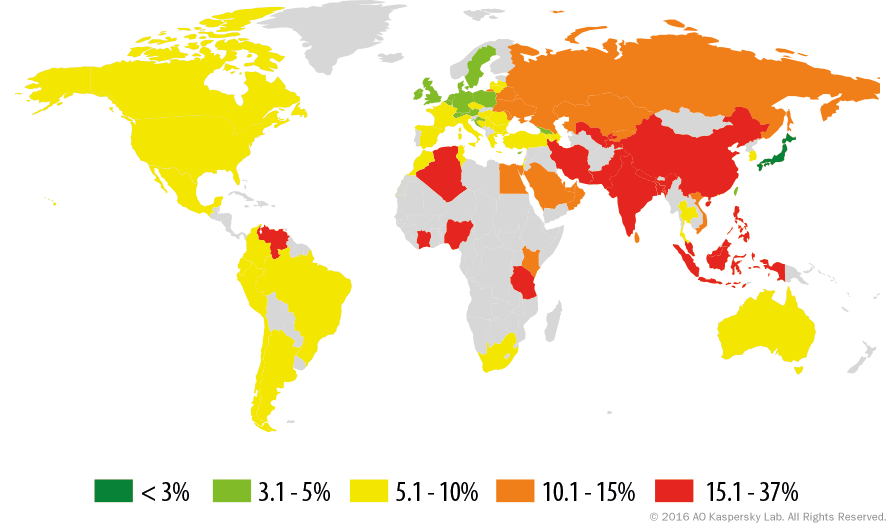


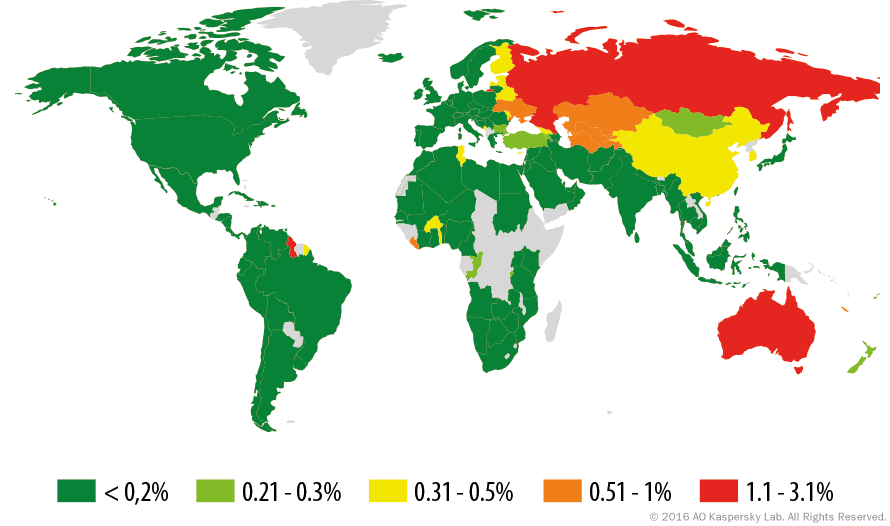
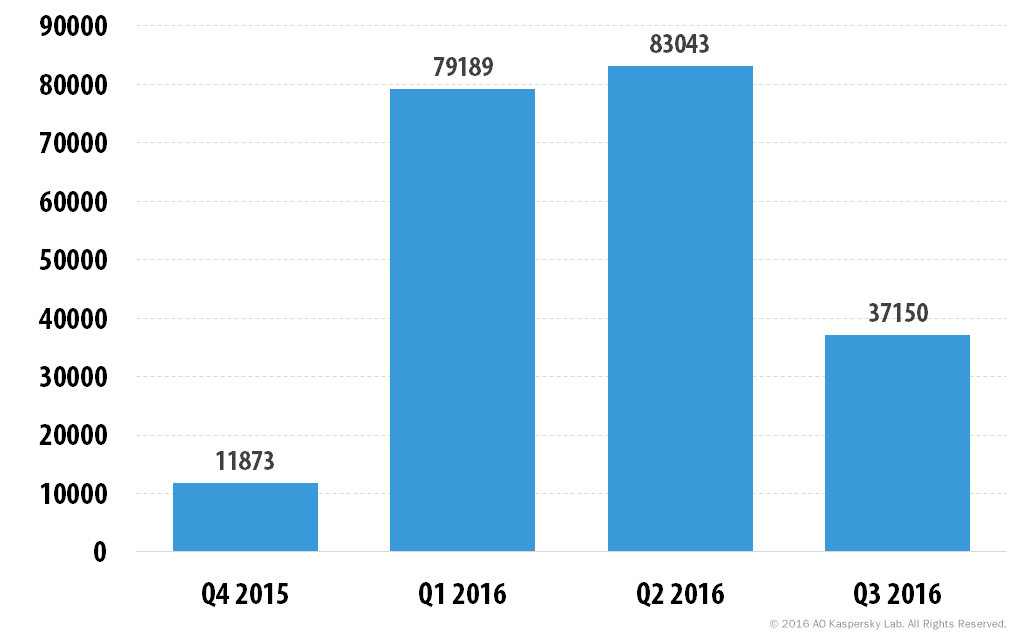



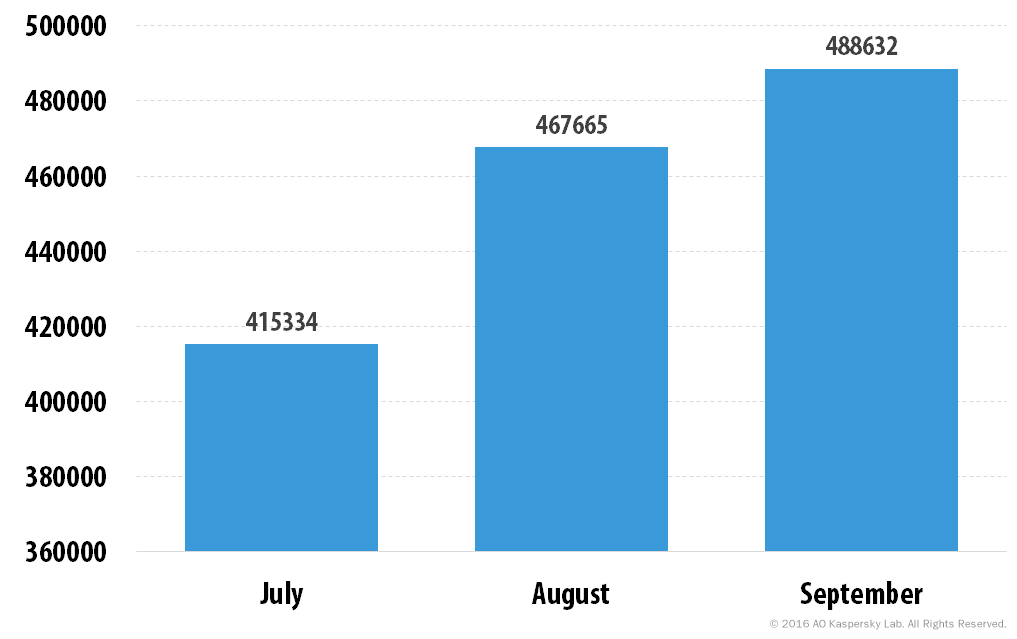





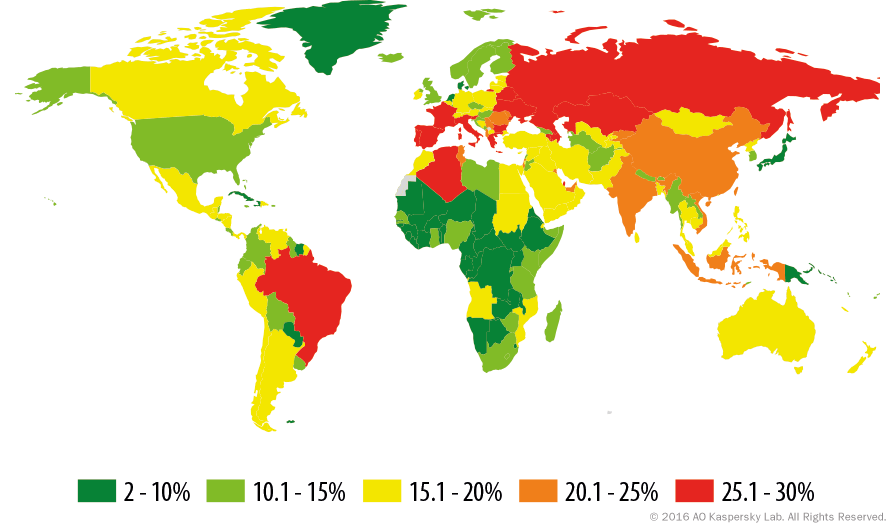



















IT threat evolution Q3 2016. Statistics